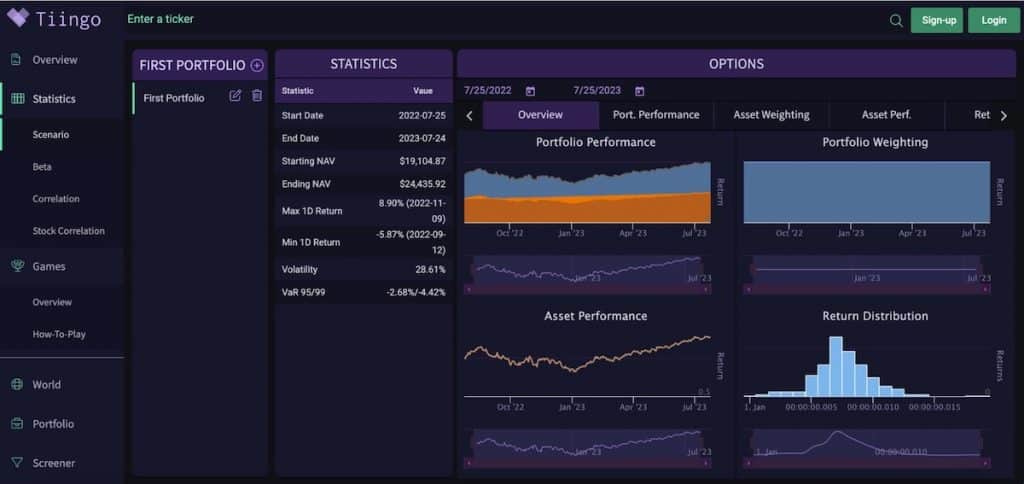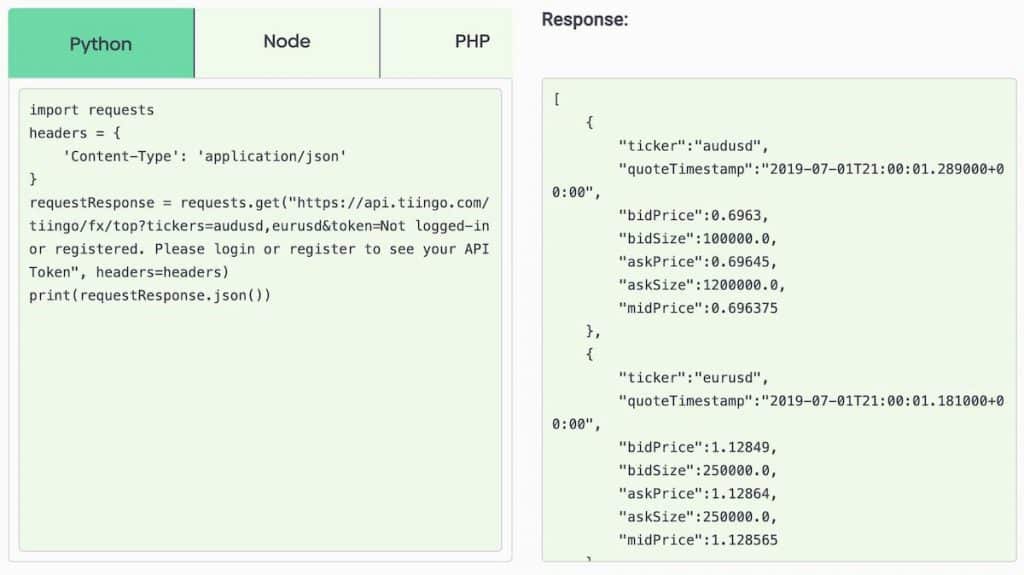
Forex trading — via foreign currency exchanges, also known as FX — is a fast-paced trading strategy. Investors and traders use statistical models and forex APIs to analyze currency price fluctuations. This analysis helps them pick the right time to buy or sell currency pairs.
Forex traders leverage algorithms, forex indicators, trading platforms, and forex APIs to make short- and long-term trading decisions. These decisions and strategies come down to numerous factors that indicate the best time to buy or sell based on the forex cross-rate. You’ve got to move fast in forex trades because even a few seconds’ delay could lose you a percentage or two in gains.
Let’s take a closer look at what financial APIs are, and more specifically what a forex API is, what its benefits are, and how to use one in your trading strategy.
What Are Financial APIs?

Application programming interfaces (APIs) are everywhere. In fact, APIs are so commonplace that the term “API economy” and the role stock APIs play in the economy, and financial markets are as essential as algorithmic trading.
An API is a software programming interface ⏤ think of it as a bridge or series of gateways ⏤ between one or more applications, software tools, or platforms. In the finance sector, financial market APIs, also known as stock APIs, allow users to tap directly into the raw data, bypassing classic graphical user interfaces (GUIs).
Whenever traders or analysts are using trading screens and software, it’s the data that’s powering and informing every decision, whether those are human input decisions or algorithmic. APIs are the data layer, and when it comes to forex trading, you can use a forex API to plug that data into any number of GUIs and trading software platforms.
Open banking and logging into an app using another online account you’ve already got (e.g., Facebook or Gmail) are examples of APIs in action. So are real-time maps that tell you when a takeout order or package is being delivered.
What Is a Forex API?
In the financial sector, there are APIs for everything from end-of-day prices to fundamental data, cryptocurrency, IEX, and the constant stream of financial news.
Forex APIs are specifically for pulling in, streaming, and aggregating historical market data and real-time (up to the second) forex currency pairs.
Exchange rates are in constant flux. Currencies are priced and move against one another based on numerous data points, such as national gross domestic products (GDPs), debt levels, jobs figures, interest rates, long-term government bond rates, and foreign exchange (forex) market speculation.
In most cases, the U.S. dollar (USD) acts as the global comparison/base currency, giving it a value of 1 in every cross-rate currency transaction. Traders are then buying and selling based on various currency pair options, e.g., yen/euro against the U.S. dollar or a pound sterling/euro pair.
A forex API is one of the most effective ways to tap into fast-moving, real-time forex data. Gaining access to an API usually involves signing up with an exchange rate data provider, and then you will be given API documentation and access to an API key. Traders usually need to know what type of endpoint they need beforehand (e.g., REST API or a WebSocket API) plugging this into any trading software or platform they’re already using.
The good thing is that traders and analysts don’t need to know programming languages — e.g., PHP, Python, Java, a JSON API, etc. — to make forex APIs work for them. The user experience set up for forex data feeds is fairly easy, and most brokers, firms, or trading platform providers will have engineers who can handle anything more complicated.
How to Use a Forex API to Inform Forex Indicators and Analysis
Foreign exchange rate APIs provide the data pipeline from forex markets into the software and trading platforms that investors use to plan, backtest, simulate, and execute forex trades.
Once you’ve got forex data plugged into your trading tools, you need to know how to use it. Although most software comes with the functionality that will automate this, it’s helpful to have a grounding in the fundamentals, known as forex indicators.
Forex indicators are based on mathematical formulas and models used to assess cross-pair and inter-currency market volatility.
Forex indicators and trading signals come in many forms, such as:
- Indicators of forex trends to follow: Keeping a close, real-time eye on the way currency pair trends are moving is the first step when implementing or stress-testing forex trading strategies.
- Indicators that confirm forex trends: Once you’ve identified which way trends are moving, you need to confirm and verify the data points. There are many ways to do this, such as using moving average convergence divergence (MACD), stochastic oscillators, and Fibonacci retracements.
- Indicators that it’s time to take a profit: Knowing the right moment to sell could maximize your profits while ensuring you avoid a sudden whipsaw movement when a currency moves in the opposite direction. Bollinger Bands are a way to assess when a profit-taking indicator is in play.
- Indications of currency pairs being overbought/oversold: Whether a currency pair is overbought or oversold could indicate whether the market is bullish or bearish and, therefore, help you decide your next move. Using a relative strength index (RSI) calculation is a valuable tool for understanding which way the market is moving and whether now is the time to buy, sell, or hold. An RSI calculator is a handy way to work this out once you’ve got the 14 data points required to make the calculation.
Moving averages, whether based on standard moving average models (e.g., 20-day, 30-day, 100-day, etc.) or somewhat more involved calculations, such as moving average convergence divergence (MACD or MSC-D) or exponential moving averages (EMAs), underpin the majority of currency pair calculations and indicators.
Benefits of a Forex API for Your Forex Trading Strategy

One of the main advantages of a forex API is you’re accessing foreign exchange trading data from the source. It’s not being filtered through third-party tools that strip away or consolidate data points, making it either less accurate or slower. This way, the data you’re using to plan forex strategies, backtest them, and execute them is as accurate, clean, and fast-moving as possible.
Forex traders value speed and accuracy. Especially if you are handling investor funds. Forex usually makes up a percentage of every investor’s portfolio and approach to risk management. Forex can be a useful hedge against other more volatile investment assets, such as crypto or high-growth tech stocks.
Depending on the extent of your market positions, even tiny gains or losses in currency pairs can equate to decent-sized profits. So, having access to fast-flowing and accurate data is a massive advantage, as a small-percentage uptick or downward movement could make a big difference in the context of a forex trading strategy.
Leverage a Fast, Enterprise-Grade Forex API for Forex Trading
Forex data comes in many formats, and because fast-moving trades depend on the quality of the data, analysts and traders need access to a forex API that produces clean, normalized forex data using a unified symbology.
Historical forex data is as valuable as real-time price movements that are accurate up to the second. With the right forex API, such as Tiingo’s, you can have both to ensure you’ve got one-minute bars for backtesting and real-time updates that contain tight spreads.
Tiingo’s forex API is institutional quality, built for speed, and connectivity, leveraging some of the fastest servers on the planet with consistent uptime that benefits from optimized in-memory caching. Tiingo’s forex API covers 140-plus currency pairs (and a handful of commodities alongside FX pairs), with historical data going back three years, and comes available in two formats: REST API and the WebSocket API.
Leave a Reply